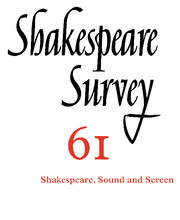Book contents
- Frontmatter
- Sarah Siddons, theatre voices and recorded memory
- Playing with Shakespeare’s play: Branagh’s Love’s Labour’s Lost
- Bottom and the gramophone: Media, class and comedy in Michael Hoffman’s A Midsummer Night's Dream
- Maurice Evans’s Richard II on Stage, Television and (Almost) Film
- Richard II on the Screen
- ‘Where Lies Your Text?’: Twelfth Night in American Sign Language Translation
- ‘This uncivil and unjust extent against thy peace’: Tim supple’s Twelfth Night, or what violence will
- ‘There’s no such thing’: nothing and nakedness in Polanski’s Macbeth
- Ghosts and mirrors: the gaze in film Hamlets
- ‘Ben, it’s a terrible thing to hate your mother’: mind control in Hamlet and The Manchurian Candidate
- Channelling the ghosts: the Wooster Group’s remediation of the 1964 Electronovision Hamlet
- Listening to Prospero’s Books
- Lend Me Your Ears: Sampling BBC Radio Shakespeare
- An Age of Kings and The ‘Normal American’
- Shakespeare and British Television
- A Local Habitation and a Name: Television and Shakespeare
- Paying attention in Shakespeare parody: from Tom Stoppard to YouTube
- Madagascan will: cinematic Shakespeares / transnational exchanges
- Still life? Anthropocentrism and the fly in Titus Andronicus and Volpone
- Riddling q1: Hamlet’s mill and the trickster
- ‘Speak, that I may see thee’: Shakespeare characters and common words
- Who do the people love?
- A Partial Theory of Original Practice
- Shakespeare Performances in England, 2007
- Professional Shakespeare productions in the British Isles, January–December 2006
- The Year's Contributions to Shakespearian Study 1 Critical studies
- 2 Shakespeare in performance
- 3a Editions and textual studies
- 3b Editions and textual studies: The RSC Complete Works
- Index to Volume 61
‘Speak, that I may see thee’: Shakespeare characters and common words
Published online by Cambridge University Press: 28 November 2008
- Frontmatter
- Sarah Siddons, theatre voices and recorded memory
- Playing with Shakespeare’s play: Branagh’s Love’s Labour’s Lost
- Bottom and the gramophone: Media, class and comedy in Michael Hoffman’s A Midsummer Night's Dream
- Maurice Evans’s Richard II on Stage, Television and (Almost) Film
- Richard II on the Screen
- ‘Where Lies Your Text?’: Twelfth Night in American Sign Language Translation
- ‘This uncivil and unjust extent against thy peace’: Tim supple’s Twelfth Night, or what violence will
- ‘There’s no such thing’: nothing and nakedness in Polanski’s Macbeth
- Ghosts and mirrors: the gaze in film Hamlets
- ‘Ben, it’s a terrible thing to hate your mother’: mind control in Hamlet and The Manchurian Candidate
- Channelling the ghosts: the Wooster Group’s remediation of the 1964 Electronovision Hamlet
- Listening to Prospero’s Books
- Lend Me Your Ears: Sampling BBC Radio Shakespeare
- An Age of Kings and The ‘Normal American’
- Shakespeare and British Television
- A Local Habitation and a Name: Television and Shakespeare
- Paying attention in Shakespeare parody: from Tom Stoppard to YouTube
- Madagascan will: cinematic Shakespeares / transnational exchanges
- Still life? Anthropocentrism and the fly in Titus Andronicus and Volpone
- Riddling q1: Hamlet’s mill and the trickster
- ‘Speak, that I may see thee’: Shakespeare characters and common words
- Who do the people love?
- A Partial Theory of Original Practice
- Shakespeare Performances in England, 2007
- Professional Shakespeare productions in the British Isles, January–December 2006
- The Year's Contributions to Shakespearian Study 1 Critical studies
- 2 Shakespeare in performance
- 3a Editions and textual studies
- 3b Editions and textual studies: The RSC Complete Works
- Index to Volume 61
Summary
Recording the number of times a particular word or phrase is used in a passage, or the relative frequency of a metrical feature or of a rhetorical figure, has been a familiar practice in Shakespeare studies for at least a century. This sort of measurement and comparison is a staple of authorship studies. Along the way these practices have suffered some swingeing blows, such as Sir E. K. Chambers’s attack of 1924 on the ‘disintegrators’, Samuel Schoenbaum’s ridicule of the ‘parallelographic school’ in the 1960s, and Brian Vickers’s recent demolition of the case for Shakespeare’s authorship of A Funerall Elegie. Nevertheless, they have proved indispensable (when soundly practised) as a complement to documentary evidence and to subjective estimates of what is, or is not, the authentic style of a particular writer. Statistical work plays a large part in Gary Taylor’s Textual Companion to the Oxford Shakespeare (Oxford, 1980), and in important recent books by Vickers himself and by MacDonald P. Jackson. It is sympathetically assessed in Harold Love’s Attributing Authorship: An Introduction (Cambridge, 2002).
Much less use has been made of these methods in describing Shakespeare’s style, or that of his peers, more generally, even in the age of effortless counting and calculation by the computer. Two exceptions are Barron Brainerd’s work on pronouns and other common words in relation to genre and period in Shakespeare’s works, and Jonathan Hope’s book on the sociolinguistics of Shakespeare’s idiolect in contrast with Fletcher’s. (Hope and Michael Whitmore have recently presented the results from a more ambitious computational stylistics venture using a complete set of Shakespeare plays.) Meanwhile there are promising precedents in other areas of English studies. John Burrows’s book Computation into Criticism: A Study of Jane Austen and an Experiment in Method (Oxford, 1987) offers remarkable insights into the patterning of Jane Austen’s language, and the subtly varied idiolects of her characters.
- Type
- Chapter
- Information
- Shakespeare Survey , pp. 281 - 288Publisher: Cambridge University PressPrint publication year: 2008

